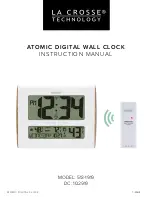
GEKCO DIGITAL CLOCK P/N CLK100 ASSEMBLY & OPERATION MANUAL
10
REV 1.1
GEKCO INC.
4.
Assembly Notes
4.1.
TOOLS
You will need these tools to assemble your kit.
•
Diagonal Cutters
•
Needle Nose Pliers
•
Flat Head Screwdriver
•
Philips Screwdriver (for the enclosure
only)
•
Pencil Soldering Iron (22 to 25
WATTS)
4.2.
ASSEMBLY
1. Follow the instructions carefully. Read the
entire step before you perform each
operation.
2. Refer to the Pictorial and Detail
Illustrations for help in performing the
assembly steps. The illustrations are
arranged in the proper sequence, as called
for in the assembly steps.
3. Pictorials show the overall operation for a
group of assembly steps: Details generally
illustrate a single step. When you are
directed to refer to a certain Pictorial “for
the following steps,” continue using that
Pictorial until you are referred to another
Pictorial for another group of steps.
4. Position all parts as shown in the
Pictorials.
5. Solder instructions are generally given only
at the end of a series of similar steps. You
may solder more often if you desire.
6. Each circuit part in an electronic kit has its
own reference designator (R3, C8, etc.).
Use these designators when you want to
identify the same part in the various
sections of the manual.
7.
SAFETY WARNING:
Avoid eye injury
when you cut off excessive lead
lengths. Wear safety glasses or
goggles and hold the leads so they
cannot fly toward your eyes.
4.3.
SOLDERING
Soldering is one of the most important
operations you will perform while assembling
your kit. A good solder connection will form an
electrical connection between two parts such
as a component lead and a circuit board foil. A
bad solder connection could prevent an
otherwise well-assembled kit from operating
properly.
It is easy to make a good solder connection if
you follow a few simple rules:
Use the right type of soldering iron. A 22 to 25-
watt pencil soldering iron with a 1/8” or 3/16”
chisel or pyramid tip works best.
Keep the soldering iron tip clean. Wipe it often
on a wet sponge or cloth: then apply solder to
the tip to give the entire tip a wet look. This
process is called tinning, and it will protect the
tip and enable you to make good connections.
When solder tends to “ball” or does not stick to
the tip, the tip needs to be cleaned and re-
tinned.
NOTE: What solder to use, leaded or lead
free? The printed circuit boards in this kit are
plated with lead free solder so if you choose to
use lead free solder the complete assembly will
be RoHS compliant. Regarding kits though, it is
more difficult to solder with lead free material
due to the higher melting temperature, so we
recommend using a rosin core, radio-type
solder (60/40) or (63/37) tin-lead content) for all
of the soldering in this kit. If you decide to use
leaded solder, be careful to wash your hands
after soldering and never eat, drink or smoke,
until you wash thoroughly and you are done
soldering. Contain all materials that touched
leaded solder in a special container dedicated
for that purpose. This waste can be disposed
of at electronic-recycling events or contact your
waste management company
Содержание CLK100
Страница 29: ...DIGITAL CLOCK MODEL CLK100 GEKCO INC Rev 1 1 29 Figure 25 Display Board Bottom Side...
Страница 30: ...GEKCO DIGITAL CLOCK P N CLK100 ASSEMBLY OPERATION MANUAL 30 REV 1 1 GEKCO INC 14 Schematic Main Board...
Страница 31: ...DIGITAL CLOCK MODEL CLK100 GEKCO INC Rev 1 1 31 15 Schematic Display Board...











































